EPISODE 10: SOUTH CAROLINA AND GEORGIA
(Just a note before I go on with this Episode. I ended last episode by saying that the WWII aspects of this trip were over. I forgot about the D-day Museum in New Orleans. I have no idea if it is open again – I think they did not suffer too much damage. But I will just have to see when I get there. Also, there is a woman who is the widow of another Lieutenant who served with my father and who survived the war but died many years ago. She lived in Norman, Oklahoma. She wrote a very nice letter to my mother shortly after my father was killed that I found among my mother’s things. I spoke to her a couple of years ago but now her number is no longer in service. I will try to find out what happened to her in Oklahoma. )
I had the feeling I was in the South mainly because of the accents I had been hearing since West Virginia and the west part of Virginia. But it really hit home after I left Southern Pines and Camp Mackall and headed south to South Carolina. I turned a bend in the road and there was this field of cotton. I am often lost as to which crops is being planted in a field and have often thought that farmers should be required to label their fields. But there was no doubt here.
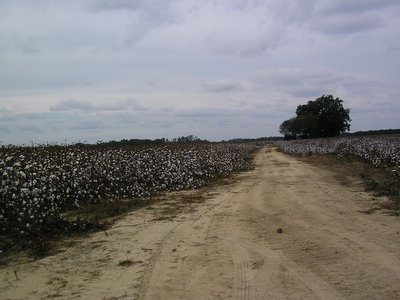
King Cotton
I headed to the town of Darlington where William Least Heat Moon had gone to a funky diner and I wanted to cross paths at least once with the author of Blue Highways. But the Deluxe Café was closed by the time I got there and it looked like it had been gentrified anyway. So I then headed down the road, past the Darlington Speedway – this is the south remember – to the nearby town of Bishopville. My objective here was the topiary gardens of Mr. Pearl Fryar as featured in the New York Times. Mr. Fryar is a former postal worker and the folks at the Post Office told me how to get to his house. He was not home but I did get to meet Mrs. Fryar. I am sorry about including so many pictures but I really got carried away and I took several that I have not even included. It is a fantastic example of art created by a normal workingman, much like the Watts Towers. And he has only been doing it for about 12 or 13 years. I really loved this place and was just sorry that Mr. Fryar was not home. The neat thing is that his neighbors have taken this up too as can be seen in the last photo (before Mrs. Fryar). (I think I saw a sign in town that said the Doc Blanchard came from here. He was the famous football player from Army, known as Mr. Inside.
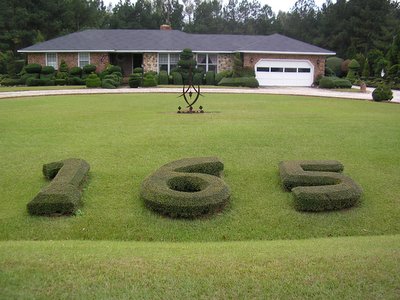
Fryar home
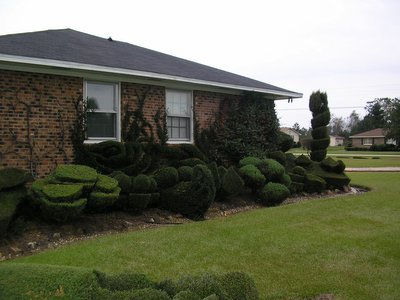
Topiary 2
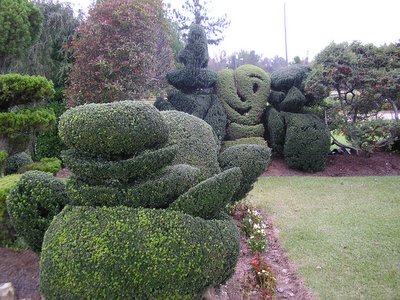
Topiary 3
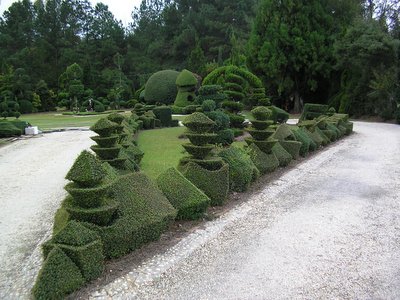
Topiary 4
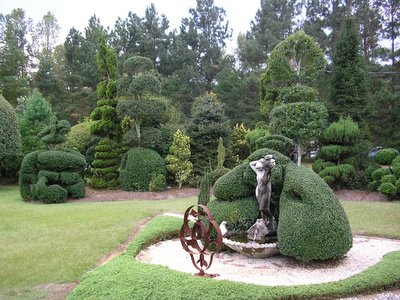
Topiary 5
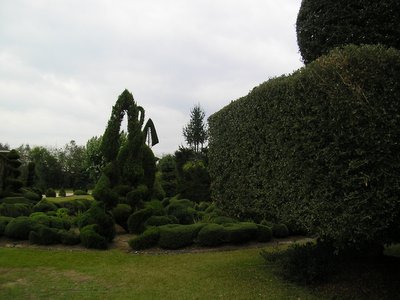
Topiary 6
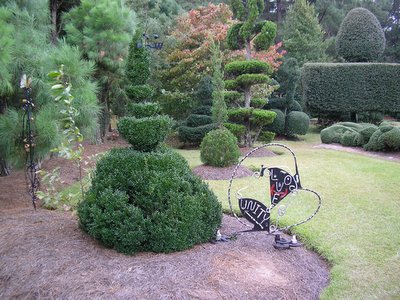
Topiary 7
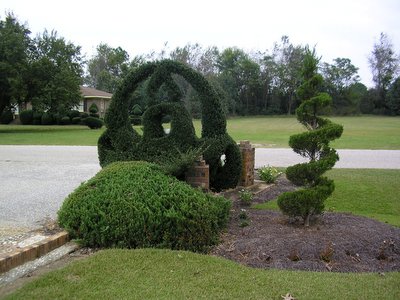
Topiary 8
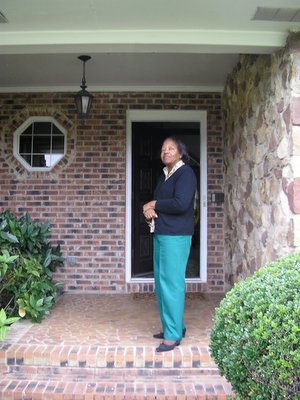
Mrs. Fryar
Then I was off to the old southern cities of Charleston and Savannah. Here are a couple of pictures of Charleston. The white church (St. Michael’s Episcopal) in the first picture was modeled after Wren’s churches in London. Life in Cabbage Row and the surrounding Creole ghetto supposedly was the inspiration for George Gershwin’s opera Porgy and Bess. The famous house is the Edmonston-Altson House.
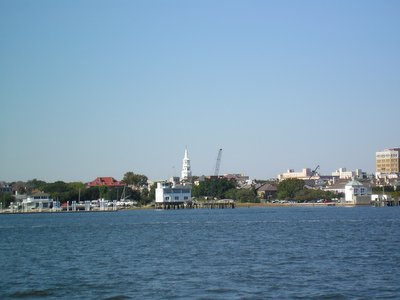
Charleston by Sea
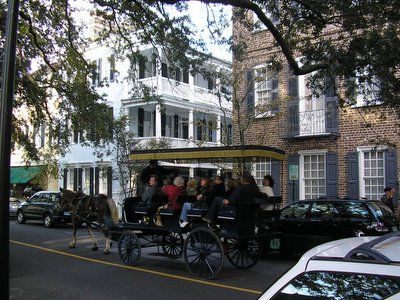
Street Scene
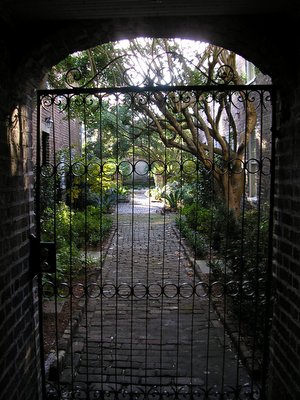
Cabbage Row

Palladian house on alley
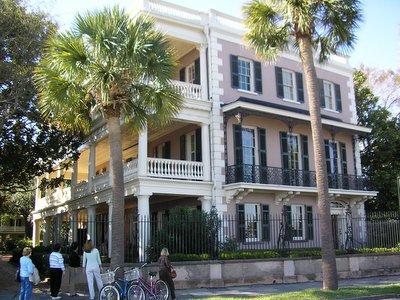
Famous house
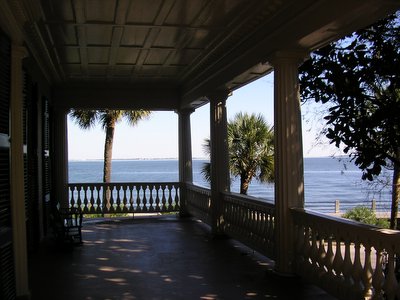
From famous house
Here is a new bridge that runs across to Patriot Point where I got a boat to Fort Sumter where the Civil War (Is that the world’s greatest oxymoron or what?) started and where Abner Doubleday from Cooperstown (later to formalize the rules of Baseball, not invent it) fired the first shot on the part of the Union Army.
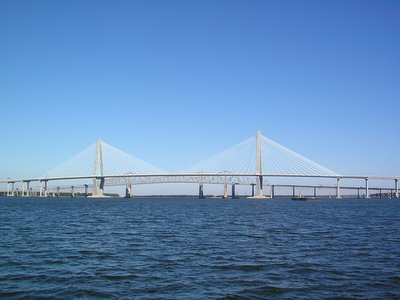
Bridge 1
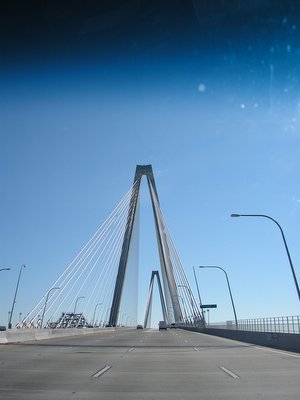
Bridge 2
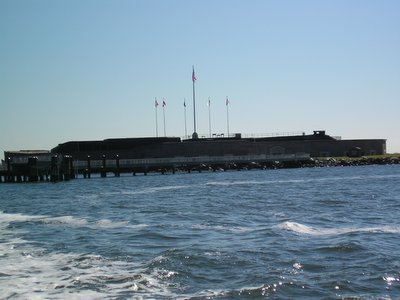
Fort Sumter
In Charleston I had the most amazing dining experience. About ten miles out of town, past some shopping malls, and down a dirt road that runs about a mile into a swamp, there is a restaurant built out of cinder blocks on Bowen Island. The woman who worked at my campground said she was amazed that the health department had not shut it down yet. They encourage you to write graffiti on the walls. Their special is all-you-can-eat oysters for under $20. The steamed oysters are dumped on your table, which is covered with newspaper and has a hole in the center over a trashcan where you throw the oyster shells. They give you a towel, an oyster knife, a bottle of hot sauce, and a package of crackers and let you go to it. I had more than a whole shovel full. I lost count but I must have opened and eaten over 75 or 100 oysters. Now, these are not all the nice pristine ones you get in restaurants – these are usually in clusters of various sizes. My left hand got wrinkled from the moist towel and I actually got more tired doing all the opening than really full. But I certainly had enough oysters to satisfy me. I have never been to a restaurant like this.
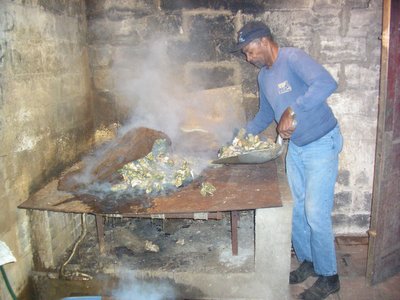
Henry at Bowen Island restaurant
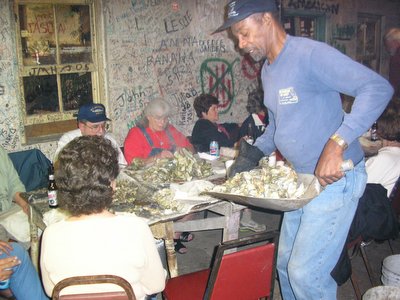
Henry dishes it out
Outside of Charleston I visited the former Middleton Plantation. The former house was pretty much destroyed by the Northern soldiers in the Civil War although the gardens are still maintained as well as a small house and outbuildings. I attended an interesting tour focusing on the slaves that made this rice plantation possible. Here are some pictures. First the butterfly lakes framing the grand entrance to the plantation from the river and the old rice mill. Then a water feature and an formal aspect of the garden. Then a more romantic informal landscaped area.
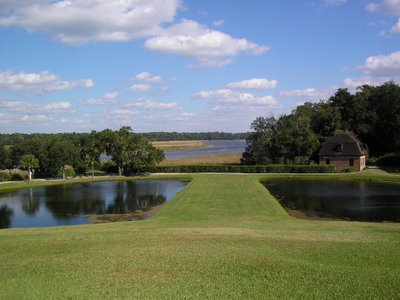
Middleton Plantation entrance
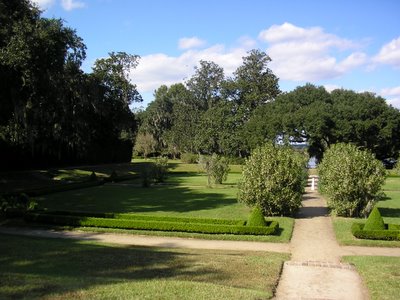
Formal garden
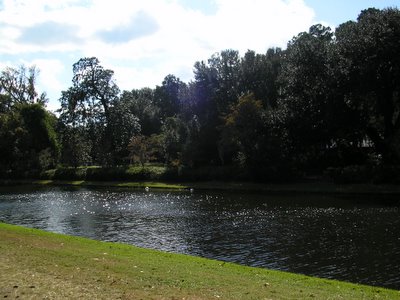
Water feature with swans
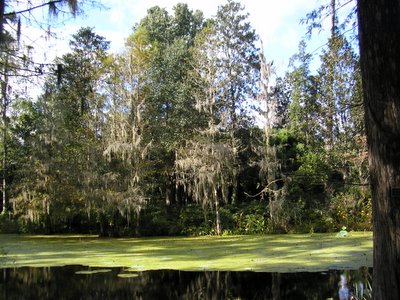
Informal woods and lake
After I left Charleston I decided to spend the night in Hilton Head because they had a Motel 6 there. I am really glad I went because, from a planning perspective, it is an amazing place. It is a result of sign, landscaping, and setback regulations gone wild. I got lost at night trying to find a restaurant because you can’t see the signs or the commercial development at night. Where are neon lights when you need them? Here is how the regulations dealt with my hotel.
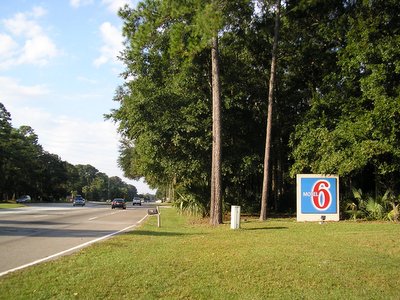
Hilton Head
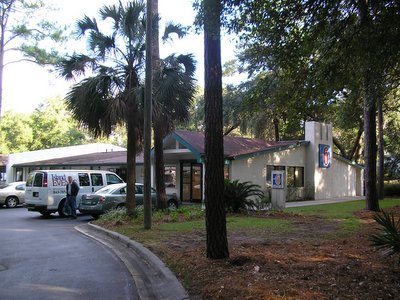
Motel 6 at Hilton Head
Just over the Georgia border is the beautiful town of Savannah. Pictures of individual buildings and squares don’t do it justice. It is the whole urban fabric (sorry) that is so wonderful with beautiful squares every few blocks. Temple Mikve Israel is the oldest congregation in the country that currently practices Reform Judaism. It was founded mainly by Spanish and Portuguese Jews who had been forced to convert to Christianity by the Inquisition and ended up in England. The Jews in London that were part of the Bevis Marks synagogue (no relation although I have been there) were glad to get these folks out of their hair and on the boat to Oglethorpe’s adventure in Gerogia. This was in the 1730s.
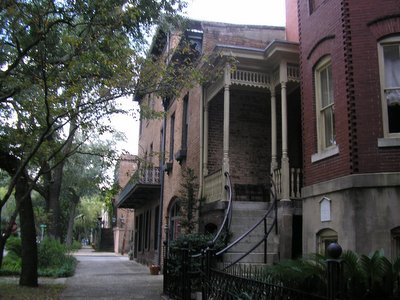
Savannah street scene
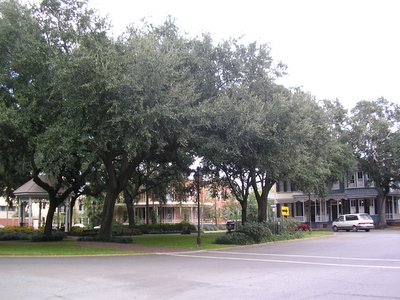
Savannah square
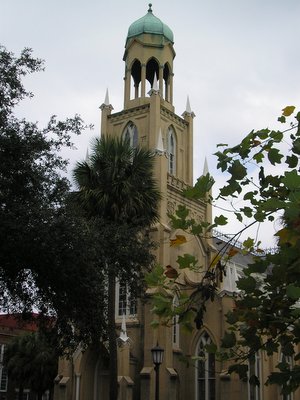
Temple Mikve Israel
Please note that I did NOT take a picture of Forest Gump’s bench nor of the stature that is on the cover of In the Garden of Good and Evil. (Actually both those items have been moved inside to museums.)
It has been a while since I have come across the world’s biggest anything and I am not really sure if this is the world’s biggest world. But maybe it is. In any case it was once a natural gas container but has not been used as such since the 1960s and the City of Savannah had it painted to attract tourists like me.
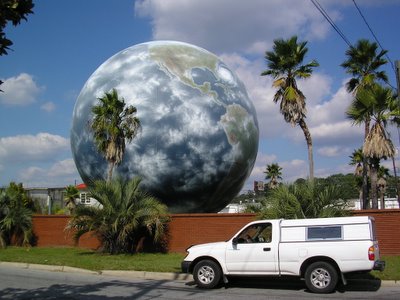
World's biggest world
I want to say a little something negative about Charleston and Savannah. Sacrilege, I know. Not really negative because I think the hearts of these old cities are as great as people say. I especially liked the layout of Savannah. But these old, historic, and preserved areas are just a small part of the overall urban environment. Outside these preserved areas (and I am glad they are preserved) one finds development that is typical of the modern landscape in the rest of the country -- that is to say, pretty ugly. Charleston outside of downtown is not terrible but is no different that other places. But one part of outer Savannah had every franchise know to humankind in an ugly urban sprawl. So I felt that these places kind of “cheat” – they are very proud of their historic areas but the areas outside of these “museums” are just like anywhere else. One could be in Bellevue.
OK, back to the road. South of Savannah I ran across what is billed as the country’s smallest church, as seen here.
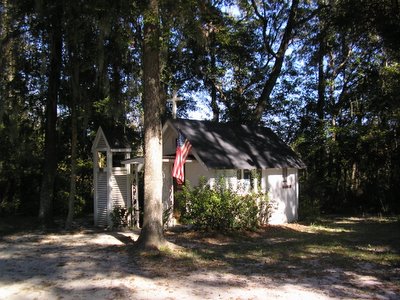
America's smallest church
A short while after I visited this church I had some Bar BQ at a place called the “GA Pig” in Brunswick. It is famous but is hidden away and I had a hard time finding it. This moment wins the prize for Most Stupid Action of the trip. I asked a couple of people where the “GAH Pig” was. And they never heard of it. It never occurred to me that the GA stood for Georgia and that is how one would call the restaurant. Finally one guy said, you mean the Georgia Pig. I felt like a really stupid Yankee. Anyway, this point was a turning point of the trip since I was now turned toward the west and even though I still have a long way home I am headed in that direction.
The last Georgia (or GA) site that I visited was the Okefenokee Swamp. It was not on my original list of things to see because I guess I did not really know where it was – I probably thought it was in Florida. But it is on the way to the Gulf Coast so I drove into Stephen Foster State Park and took a little boat ride. On the ride were two retired women who used to teach at San Francisco State – one woman started teaching there the first year that I went there and we had some mutual acquaintances on the faculty. Our guide/driver was very knowledgeable about his swamp; he asked me about something he read in the paper – that in Washington state people are only allowed to develop 30 percent of their property. This go us started on a discussion of critical area regulations.
The Okefenokee is the headwaters of the Swannee (or Suwannee as it is spelled here) River. They are big on Stephen Foster down here even though he was from Pittsburgh. They are lucky that he changed the song from the original lyrics. It first was Way Down Upon the Peedee River – a river up in South Carolina that I crossed a couple of times, singing the song with the original lyrics.
In any case, I really loved the Okefenokee even though I did not see Pogo.

Okefenokee Swamp
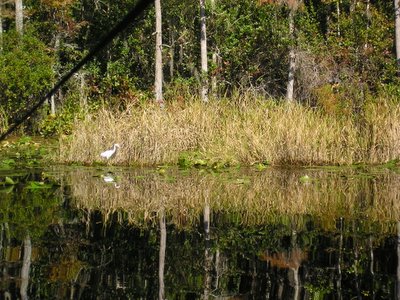
Egret
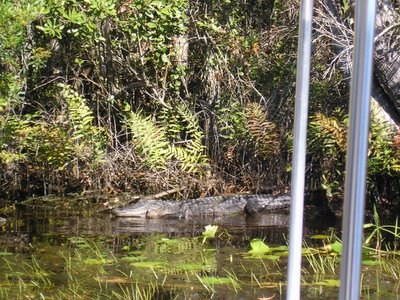
Mr. Ali

0 Comments:
Post a Comment
<< Home